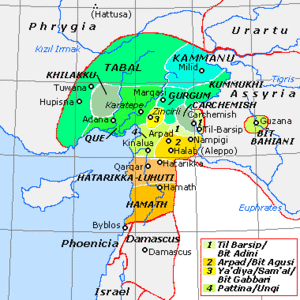History
Palistin was one of the Syro-Hittite states that emerged in Syria after the Late Bronze Age collapse. [1]
It dates to at least the 11th century BC and is known primarily through the inscriptions of its king Taita and his wife. [1] The kingdom emerged some time soon after the collapse of the Hittite Empire, of which it is one of the successor states, and it encompassed a relatively extensive area, stretching at least from the Amouq Valley in the west, to Aleppo in the east, down to Mhardeh and Shaizar in the south. [2] Prof. Itamar Singer proposes that it was the predecessor state that, once it disintegrated, gave birth to the kingdoms of Hamath, Bit Agusi and Pattin (shortened form of Palistin). [3]
Archaeological evidence
The excavations at Tell Tayinat in the Turkish Hatay province which might have been the capital of Palistin, [4] revealed two settlements, the first being a Bronze Age Aegean farming community, and the second an Iron Age Syro-Hittite city built on top of the Aegean farming settlement. [3] Palistin is attested as Walistin in an inscription discovered in 1936 at the site. [5]
Palistin ("Watasatina") is also attested in the Sheizar Stele, which is the funerary monument of Queen Kupapiya, the wife of Taita. [6] Another stele, discovered in Meharde, might well be the funerary monument of King Taita. Both stelae mention the name of Taita, and invoke a "divine Queen of the Land", possibly the goddess Kubaba. [6] Most importantly, in 2003 a statue of King Taita bearing his inscription in Luwian was discovered during excavations conducted by German archeologist Kay Kohlmeyer in the Citadel of Aleppo. [1] [7]
Possible link to Philistines
While Hittitologist John David Hawkins initially gave two transcriptions of the Aleppo inscriptions, Wadasatini and Padasatini, a later reading suggests a third possible interpretation: Palistin. [4] The similarity between Palistin and names for the Philistines, [8] such as the Ancient Egyptian Peleset and the Hebrew פְּלִשְׁתִּים Plištim, have led archaeologists Benjamin Sass [9] and Kay Kohlmeyer to hypothesize a connection. It has even been suggested, for instance, that the area around Kunulua (Calno; Tell Tayinat) may even have been part of a Philistine urheimat. [10]
Gershon Galil suggests that King David halted the Arameans’ expansion into the Land of Israel on account of his alliance with the southern Philistine kings, as well as with Toi, king of Ḥamath (mentioned in the Bible), who is identified with Taita II, king of Palistin (the northern Sea Peoples). [11]
According to Galil, there are now eight inscriptions recently discovered at different sites indicating that a large kingdom named Palistin existed in this area, which included the cities of Hamath, Aleppo and Carchemish. [12]
The proposed Palistin-Philistines link remains controversial. [2] [8] According to Hittitologist Trevor Bryce, the connection between the biblical Philistines and the kingdom of Palistin remains a hypothesis and further excavations are needed to establish such a connection. [2] The Shaizar and Meharde inscriptions apparently preserve the ethnonym Walistin and there is no clear explanation for the alternation between a character signifying Wa- in the Shaizar and Meharde inscriptions and one signifying Pa- in the Aleppo inscriptions. [8]
If it was the case – as has been proposed by some theories concerning the Sea Peoples – that they originated in the Aegean area, there is no evidence from the Syro-Hittite artefacts at Tell Tayinat, either pictorial nor philological, to indicate a link to known Aegean civilizations. [3] On the contrary, most of the discoveries at Tell Tayinat indicate a typical Luwian state. To cite two examples: firstly, the Syro-Hittite inhabitants used predominantly red slipped burnished ware, which is totally different from the Aegean-type pottery used by the early farming inhabitants. [3] And secondly, the names of the kings of Palistin and the kings of the successor state of Pattin are also Hittite, [3] even though there is no evidence of a direct link between Taita and the old Hittite royal house. It has since been proposed, based on material evidence and epigraphical parallels, that some Philistines did in fact settle in Kinalua, living alongside the indigenous inhabitants before assimilating into the Luwian population of what became a typical Neo-Hittite state in all but its name, which was all that remained of the Early Iron Age Sea Peoples settlers. [3] [13] [14] [15]

The Philistines were an ancient people who lived on the south coast of Canaan during the Iron Age. The Philistines originated as an immigrant group from the Aegean that settled in Canaan circa 1175 BCE. Over time, they gradually assimilated elements of the local Levantine societies while preserving their own unique culture. In 604 BCE, the Philistine polity, after having already been subjugated for centuries by the Neo-Assyrian Empire, was finally destroyed by King Nebuchadnezzar II of the Neo-Babylonian Empire. After becoming part of his empire and its successor, the Persian Empire, they lost their distinct ethnic identity and disappeared from the historical and archaeological record by the late 5th century BCE.
Tunna, also Dunna or Atuna, was an ancient Anatolian city. In classical antiquity Tunna was known as Tynna. Today it is known as Porsuk Hüyük or Zeyve Höyük.

Carchemish ; also spelled Karkemish; Turkish: Karkamış) was an important ancient capital in the northern part of the region of Syria. At times during its history the city was independent, but it was also part of the Mitanni, Hittite and Neo-Assyrian Empires. Today it is on the frontier between Turkey and Syria.

Tyana, earlier known as Tuwana during the Syro-Hittite period, and Tuwanuwa under the Hittite Empire, was an ancient city in the Anatolian region of Cappadocia, in modern Kemerhisar, Niğde Province, Central Anatolia, Turkey. It was the capital of a Luwian-speaking Neo-Hittite kingdom in the 1st millennium BC.
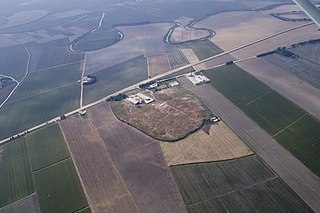
Tell Ta'yinat is a low-lying ancient tell on the east bank at the bend of the Orontes River where it flows through the Amuq valley, in the Hatay province of southeastern Turkey about 25 kilometers south east of Antakya, and lies near Tell Atchana, the site of the ancient city of Alalakh. Tell Ta'yinat has been proposed as the site of Alalaḫu, inhabited in late 3rd millennium BC, mentioned in Ebla's Palace G archive; and in later times as Kinalua, the capital city of an Iron Age Neo-Hittite kingdom.

The states called Syro-Hittite, Neo-Hittite, or Luwian-Aramean, were Luwian and Aramean regional polities of the Iron Age, situated in southeastern parts of modern Turkey and northwestern parts of modern Syria, known in ancient times as lands of Hatti and Aram. They arose following the collapse of the Hittite New Kingdom in the 12th century BCE, and lasted until they were subdued by the Assyrian Empire in the 8th century BCE. They are grouped together by scholars, on the basis of several cultural criteria, that are recognized as similar and mutually shared between both societies, northern (Luwian) and southern (Aramean). Cultural exchange between those societies is seen as a specific regional phenomenon, particularly in light of significant linguistic distinctions between the two main regional languages, with Luwian belonging to the Anatolian group of Indo-European languages, and Aramaic belonging to the Northwest Semitic group of Semitic languages. Several questions related to the regional grouping of Luwian and Aramaean states are viewed differently among scholars, including some views that are critical towards such grouping in general.
King Tou or Toi is the name of a biblical king of Hamath, an ancient city located in Syria. He is referred to in 2 Samuel 8:9–10 as "Toi" and 1 Chronicles 18:9–10 as "Tou". Both biblical accounts state that Tou paid homage to David, king of Israel, because he had defeated the army of Tou's enemy, Hadadezer, king of Zobah.
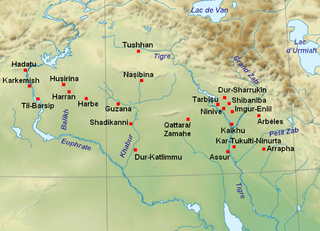
Til Barsip or Til Barsib is an ancient site situated in Aleppo Governorate, Syria by the Euphrates river about 20 kilometers south of ancient Carchemish.
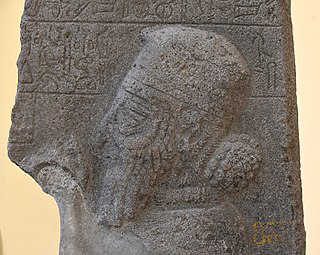
Warpalawas II was a Luwian king of the Syro-Hittite kingdom of Tuwana in the region of Tabal who reigned during the late 8th century BC, from around c. 740 to 705 BC.
The Luwians were an ancient people in Anatolia who spoke the Luwian language. During the Bronze Age, Luwians formed part of the population of the Hittite Empire and adjoining states such as Kizzuwatna. During the Hittite New Kingdom, Luwian replaced Hittite as the empire's dominant language. In the early Iron Age, a number of Luwian-speaking Neo-Hittite states arose in northern Syria. The Luwians are known largely from their language, and it is unclear to what extent they formed a unified cultural or political group.
Sangara or Sangar was a king of Carchemish. He belonged to the House of Suhi of Carchemish, and ruled from 870 to 848 BC.
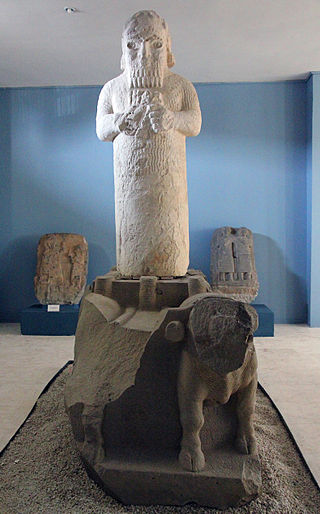
The Çineköy inscription is an ancient bilingual inscription, written in Hieroglyphic Luwian and Phoenician languages. The inscription is dated to the second half of the 8th century BC. It was uncovered in 1997 near the village of Çine, that is located some 30 km south of Adana, capital city of the Adana Province in southern Turkey.
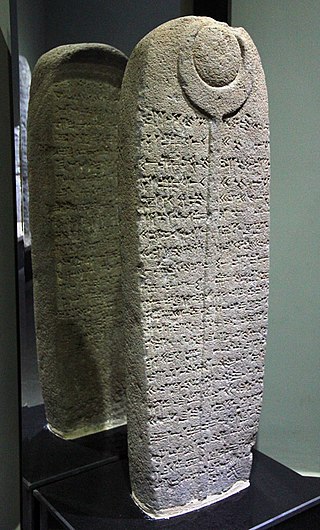
The Pazarcık Stele is an Assyrian monument which functioned as a boundary stone erected by the Assyrian king Adad-nirari III in 805 BC to demarcate the border between the kingdoms of Kummuh and Gurgum. The reverse and obverse of the stele have been inscribed in the Akkadian language in different times.

Luhuti, Lukhuti or Lu'ash, was an Iron Age Syro-Hittite Aramean region during the early 1st millennium BC located in northern Syria, in an area that used to be called Nuhašše.

Pattin, was an ancient Luwian Syro-Hittite state at the beginning of the 1st millennium BC. It was known to the Assyrians as Unqi and Aramaeans as Unqu.

Zakkur was the ancient king of Hamath and Luhuti in Syria. He ruled around 785 BC. Most of the information about him comes from his basalt stele, known as the Stele of Zakkur.

Irhuleni was King of Hamath. He led a coalition against the Assyrian expansion under Shalmaneser III, alongside Hadadezer of Damascus. This coalition succeeded in 853 BC in the Battle of Qarqar a victory over the Assyrians, halting their advance to the west for two years. Later Irhuleni maintained good relations with Assyria. His son was, in Luwian, Uratami.
The House of Suhi was a dynasty of rulers of Carchemish. The members of this dynasty are best known to us through Hieroglyphic Luwian sources. Only one member of the house of Suhi is specifically mentioned in Assyrian sources. The House of Suhi was followed by a dynasty known as the House of Astiruwa.
Hartapu was an Anatolian king in the 8th century BCE. He is known from Hieroglyphic Luwian inscriptions from Kizildağ, Mount Karadağ, Burunkaya near Aksaray, and most recently Türkmen-Karahöyük, site of a monumental stele in which he claimed victory over the kingdom of Phrygia, ruled around that time by King Midas.

